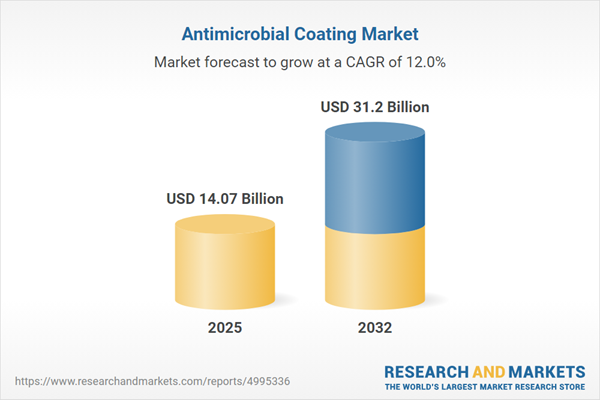Speak directly to the analyst to clarify any post sales queries you may have.
Antimicrobial coating solutions have emerged as a strategic resource for organizations focused on resilient hygiene management, risk reduction, and regulatory confidence. These coatings, tailored to industry-specific challenges, support operational excellence and ensure alignment with evolving compliance demands for senior leadership teams.
Antimicrobial Coating Market Snapshot
The antimicrobial coating market is achieving notable growth, marked by a compound annual growth rate (CAGR) of 12.01%. In 2024, the sector stands at USD 12.58 billion and is anticipated to reach USD 14.07 billion by 2025. Longer-term, market value is projected to climb to USD 31.20 billion by 2032.
This upward trajectory reflects broadening adoption throughout industries such as aerospace, healthcare, transportation, electronics, and construction. Companies prioritize these solutions to protect assets, meet compliance benchmarks, and respond effectively to stricter hygiene and sustainability standards. Shifts in global regulation and the emphasis on sustainable procurement continue to guide investment and technology strategies within this market.Scope & Segmentation of the Antimicrobial Coating Market
- End-Use Industries: Aerospace, automotive, construction, electronics, food and beverage, marine, medical devices, and transportation sectors each seek coatings that resolve sector-specific operational and compliance challenges.
- Types: Antibacterial, antifungal, and antiviral coatings respond to environmental contamination risks unique to each industry and asset profile.
- Technologies: Copper-based nanoparticles, silver-ion additives, and quaternary ammonium compounds drive antimicrobial efficacy, while titanium dioxide, zinc oxide, and advanced alloys enhance durability and broaden pathogen defense.
- Application Methods: Brush, dip, roll, and spray techniques allow organizations to tailor coating processes—either to specific equipment or for wider asset coverage—optimizing maintenance schedules and operational adaptability.
- Forms: Gels, liquids, powders, and sprays provide flexible approaches to application, supporting different operational workflows and streamlining upkeep requirements for diverse assets.
- Geographies Covered: The Americas, Europe, Middle East & Africa, and Asia-Pacific present diverse regulatory environments and technology implementation rates, making regional familiarity vital for successful market entry and risk management.
- Companies Analyzed: Leading entities, including PPG Industries, Akzo Nobel N.V., The Sherwin-Williams Company, RPM International, BASF SE, The Dow Chemical Company, 3M Company, Evonik Industries, Lonza Group, and Hempel A/S, set performance benchmarks and shape future R&D priorities.
Key Takeaways for Senior Decision Makers
- Adopting antimicrobial coatings advances core hygiene initiatives, mitigates operational risks, and supports ongoing stakeholder trust in high-compliance environments.
- Technological innovations in nanomaterials and metal-ion chemistry equip leaders with scalable protection adaptable to both specialized and general applications.
- Strategic supply chain design, including disciplined supplier qualification and robust procurement, promotes compliance under intensifying regulatory oversight of ingredients and processes.
- Collaborative projects with academic and research partners expedite tailored development, ensuring products align with unique operational and regulatory demands.
- Integrating digital and intelligent coating technologies improves monitoring, maintenance efficiency, and compliance documentation for streamlined asset lifecycle management.
- ESG-centric procurement and responsible manufacturing reinforce broader sustainability objectives, adding resilience in procurement strategy and reputation management.
Tariff Impact and Supply Chain Adaptation
Recent modifications in U.S. tariffs on key metal-ion inputs require organizations to revisit sourcing and production models. Actions such as diversifying suppliers, boosting regional manufacturing capabilities, and reformulating products help maintain operational continuity and regulatory responsiveness as both local and global supply dynamics evolve.
Methodology & Data Sources
This report is grounded in peer-reviewed scientific studies, validated regulatory documentation, and interviews with sector specialists. Independent verification enhances the accuracy of market intelligence, equipping leaders with reliable information for planning and strategic action.
Why This Report Matters: Antimicrobial Coating Market
- Enables executive teams to drive informed choices on antimicrobial coating integration, reinforcing compliance and risk management across varied sectors.
- Provides precise segmentation and region-specific analysis, supporting investment planning and helping organizations capitalize on growth prospects.
- Advises on refining procurement and supply chain approaches, ensuring alignment with tariff shifts and embedding ESG principles into organizational operations.
Conclusion
Pioneering organizations that adopt antimicrobial coating technologies and evolve procurement strategies are better equipped to meet regulatory developments and changing market requirements. This report delivers actionable guidance for those committed to advancing operational resilience and sustainable performance.
Additional Product Information:
- Purchase of this report includes 1 year online access with quarterly updates.
- This report can be updated on request. Please contact our Customer Experience team using the Ask a Question widget on our website.
Table of Contents
3. Executive Summary
4. Market Overview
7. Cumulative Impact of Artificial Intelligence 2025
Companies Mentioned
The companies profiled in this Antimicrobial Coating market report include:- PPG Industries, Inc.
- Akzo Nobel N.V.
- The Sherwin-Williams Company
- RPM International Inc.
- BASF SE
- The Dow Chemical Company
- 3M Company
- Evonik Industries AG
- Lonza Group AG
- Hempel A/S
Table Information
| Report Attribute | Details |
|---|---|
| No. of Pages | 185 |
| Published | October 2025 |
| Forecast Period | 2025 - 2032 |
| Estimated Market Value ( USD | $ 14.07 Billion |
| Forecasted Market Value ( USD | $ 31.2 Billion |
| Compound Annual Growth Rate | 12.0% |
| Regions Covered | Global |
| No. of Companies Mentioned | 11 |









